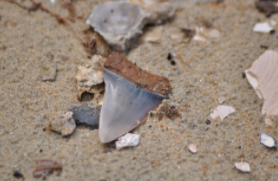Photo credit: Virginia State Parks | CC
IMPORTANT NOTICE: This trip (6/27) and all the Stratford Cliffs trip to follow have a check-in time from 8:30 to 8:45 from now on. Please try your best to get there earlier than 9:30 because there is more paperwork in COVID times. Thank you!
Please note: This field trip will be conducted under our new COVID-19 specific guidelines. Everyone attending the trip must:
- Wear a mask
- Bring your own hand sanitizer
- Keep physical distance of at least 6 feet
- Stay home if you are not feeling well, or if you have been in physical proximity to someone who has tested positive for COVID-19 or is showing symptoms.
- More information will be sent to participants.
We are returning to Stratford Cliffs for some fossil searching and hope you can join us!
Stratford Cliffs, located in Montross, Virginia (on the south side of the Potomac River, adjacent to Westmoreland State Park) is part of the Stratford Hall plantation owned by four generations of the Lee family (and is now cared for by the Robert E. Lee Memorial Foundation).
The estate encompasses 1900 acres of farmlands and forests on a high bluff overlooking the Potomac River. The Cliffs, which are part of the Calvert Formation, are a rare geological phenomenon. The Calvert Formation cliffs along the Chesapeake Bay and Potomac River rank among the most important fossil research sites in the Mid-Atlantic region. They were formed when land replaced an ancient sea. Fossils found here are composed of compacted marine plant and animal matter dating from the Miocene Epoch–approximately 17 to 10 million years ago.
Fossilized remains found at this site indicate a sea filled with primitive shark-toothed porpoises, salt-water crocodiles, sea cows, gopher turtles, rays, whales and sharks. Thousands of shark teeth found along this area attest to the frequency of the sharks, largest among them being Carcharodon megalodon, or Giant White Shark, with teeth measuring 7 inches or more.
Most of the land along the shoreline is privately owned, and public access is severely limited, so we are lucky to have this opportunity!
The driving time from Baltimore is an estimated 3 hours.
Difficulty: This field trip is moderately strenuous (derived from the combination of the colder weather by the water and decent hiking). Depending on what storms have impacted the river, there could be washed up trees and debris on the beach, as well as broken glass. There could be a few scramble spots.
Additional information on what to wear and bring will be provided to attendees closer to the trip date.
Please contact Vanessa at vlubiner@marylandnature.org with any questions.

